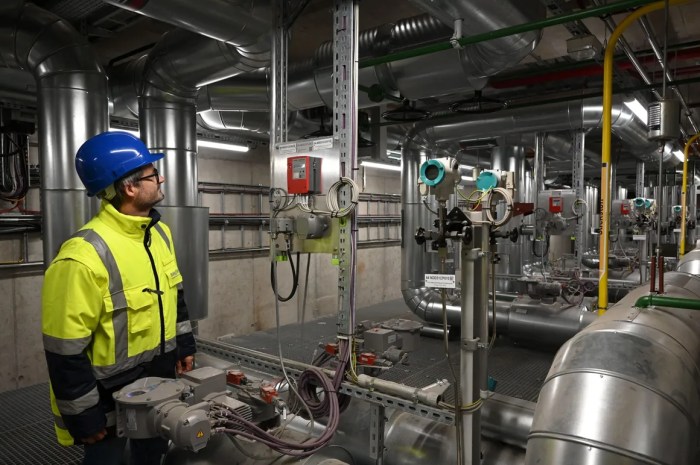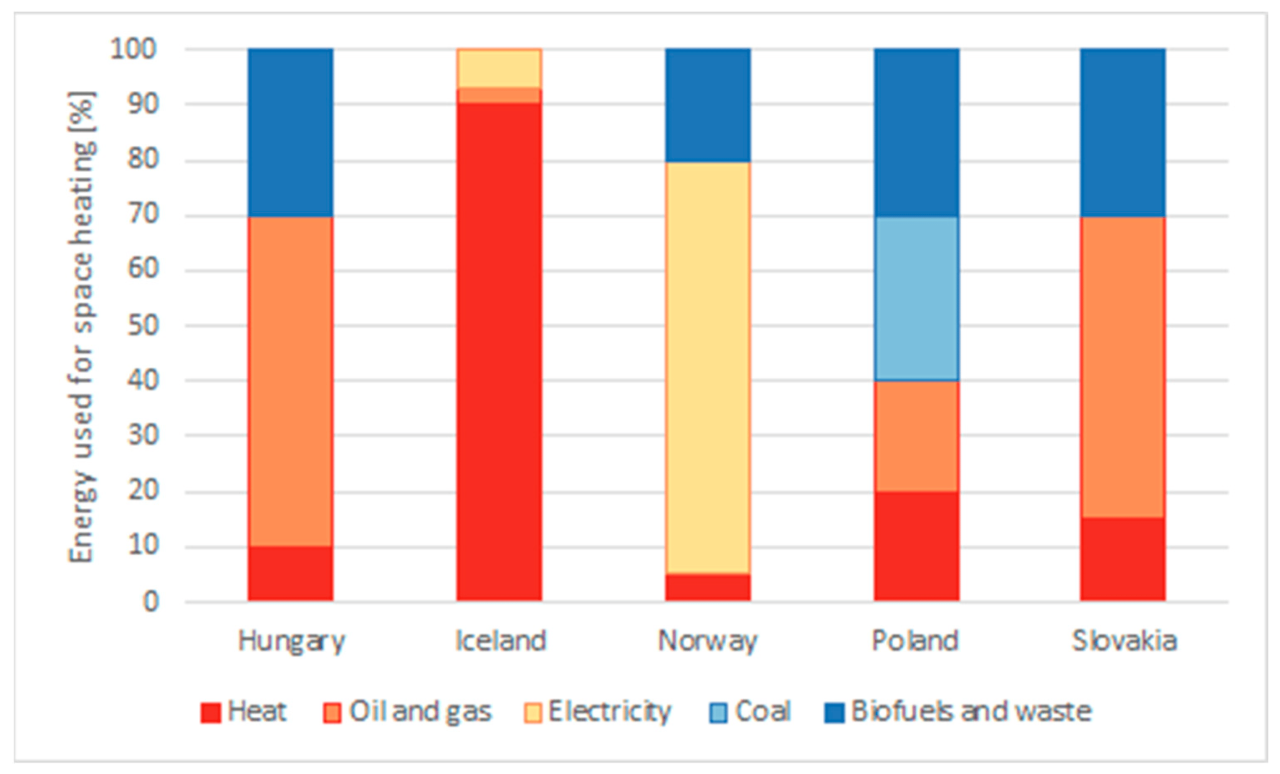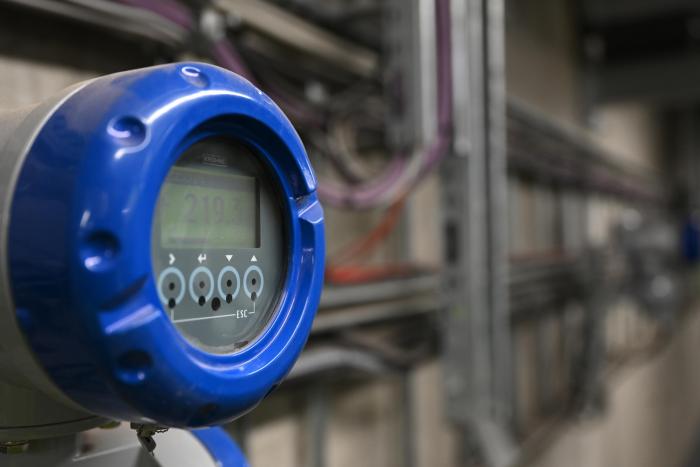Europe Wants Geothermal Energy to Replace Natural Gas, a bold statement that reflects the continent’s urgent need to shift away from fossil fuels and embrace cleaner energy sources. The current reliance on natural gas has become increasingly precarious due to geopolitical tensions and volatile prices.
This has spurred a search for sustainable alternatives, with geothermal energy emerging as a promising solution.
Geothermal energy, harnessed from the Earth’s heat, offers a stable and reliable source of power, free from the fluctuations and environmental concerns associated with fossil fuels. This renewable energy source has the potential to significantly reduce Europe’s dependence on imported gas, contributing to energy independence and a cleaner environment.
The Current Energy Landscape in Europe

Europe’s energy landscape is currently dominated by fossil fuels, with natural gas playing a significant role in meeting the continent’s energy needs. This reliance on natural gas, however, presents a number of challenges and risks, particularly in light of recent geopolitical events.
The Reliance on Natural Gas in Europe
Europe’s heavy reliance on natural gas is a consequence of its historical energy policies and infrastructure development. Natural gas has long been seen as a cleaner alternative to coal, and its use has grown significantly in recent decades. The continent’s dependence on natural gas imports is particularly pronounced, with many countries relying on supplies from Russia, Norway, and other sources.
Challenges and Risks Associated with Natural Gas Dependence
The dependence on natural gas imports exposes Europe to a range of vulnerabilities, including:
- Price Volatility:Global natural gas prices can fluctuate significantly, impacting the cost of energy for consumers and businesses. This volatility is often exacerbated by geopolitical events and supply disruptions.
- Supply Disruptions:Geopolitical tensions or unforeseen events can disrupt natural gas supplies, leading to energy shortages and price spikes. This vulnerability has been highlighted by the recent conflict in Ukraine, which has led to a significant reduction in Russian gas flows to Europe.
- Environmental Concerns:While natural gas is often considered a cleaner fuel than coal, it still emits greenhouse gases, contributing to climate change. Moreover, the extraction and transportation of natural gas can have environmental impacts, including methane leaks and habitat destruction.
The Current Geopolitical Situation Impacting Natural Gas Supply
The current geopolitical situation in Europe is characterized by heightened tensions between Russia and the West, primarily due to the ongoing conflict in Ukraine. This has significantly impacted natural gas supply, as Russia has reduced gas flows to Europe in response to Western sanctions.
This situation has led to a scramble for alternative gas sources and has highlighted the need for greater energy independence in Europe.
European Natural Gas Imports and Sources
Europe’s reliance on natural gas imports is significant, with the continent importing over 40% of its natural gas needs. The primary sources of these imports are:
- Russia:Historically, Russia has been the largest supplier of natural gas to Europe, accounting for over 40% of total imports. However, recent geopolitical events have significantly reduced Russian gas flows to the continent.
- Norway:Norway is a major supplier of natural gas to Europe, accounting for around 20% of total imports. Norway’s gas reserves are considered relatively secure and stable, making it a key partner for European energy security.
- Other Sources:Europe also imports natural gas from other countries, including Algeria, Qatar, and the United States. These sources are generally less significant than Russia and Norway, but they play a crucial role in diversifying Europe’s energy supply.
The Potential of Geothermal Energy
Europe’s reliance on fossil fuels has significant environmental and economic consequences. Geothermal energy, a renewable and sustainable energy source, presents a viable alternative for reducing Europe’s carbon footprint and enhancing energy security. This section explores the potential of geothermal energy in Europe, highlighting its advantages, different technologies, and feasibility across various regions.
Advantages of Geothermal Energy
Geothermal energy offers several advantages over traditional energy sources, making it an attractive option for Europe’s energy transition.
- Clean and Renewable:Geothermal energy is a renewable resource, meaning it is constantly replenished by the Earth’s internal heat. It does not produce greenhouse gases or air pollutants, contributing to cleaner air and a healthier environment.
- Reliable and Consistent:Geothermal power plants can operate 24/7, regardless of weather conditions. This consistent energy supply enhances energy security and reduces dependence on intermittent renewable sources like solar and wind.
- Baseload Power:Geothermal energy can provide baseload power, which is the minimum amount of electricity needed to meet demand at all times. This stability is crucial for maintaining a reliable power grid.
- Economic Benefits:Geothermal energy creates jobs and stimulates economic activity in local communities. It also reduces energy costs and enhances energy independence.
Comparison with Other Renewable Energy Sources
Geothermal energy compares favorably to other renewable energy sources in terms of its advantages and limitations.
- Solar and Wind:While solar and wind energy are also renewable, their output is intermittent, depending on weather conditions. Geothermal energy, on the other hand, provides a consistent and reliable energy source.
- Hydropower:Hydropower is another reliable renewable energy source, but it is limited by geographic factors. Geothermal energy is more widely available and can be deployed in various locations.
Types of Geothermal Energy Technologies
Different geothermal energy technologies are available, each with its own characteristics and suitability for specific applications.
- Hydrothermal:This technology utilizes hot water and steam directly from underground reservoirs to generate electricity. It is the most common type of geothermal energy technology and is suitable for areas with high geothermal gradients.
- Enhanced Geothermal Systems (EGS):EGS technology involves injecting water into hot, dry rock formations to create artificial reservoirs. This technology allows for geothermal energy production in areas where natural reservoirs are not readily available.
- Geothermal Heat Pumps:Geothermal heat pumps utilize the constant temperature of the Earth to heat and cool buildings. This technology is highly efficient and can significantly reduce energy consumption.
Feasibility of Geothermal Energy Deployment
The feasibility of geothermal energy deployment varies across different European regions due to factors like geological conditions, resource availability, and regulatory frameworks.
- Central and Eastern Europe:These regions have significant geothermal potential, particularly for hydrothermal and EGS technologies. Countries like Hungary, Romania, and Poland have already made progress in developing geothermal energy resources.
- Southern Europe:Southern European countries, such as Italy and Greece, have a long history of geothermal energy utilization. They have abundant geothermal resources, primarily for hydrothermal power generation.
- Northern Europe:Northern European countries, such as Iceland and Finland, have vast geothermal resources, primarily for direct heating and electricity generation. Iceland, in particular, is a world leader in geothermal energy utilization.
Geothermal Energy Development in Europe

Europe is taking significant strides towards harnessing the power of geothermal energy, with numerous initiatives and projects underway to accelerate its adoption. This section delves into the current state of geothermal energy development in Europe, exploring key initiatives, supporting policies, challenges, and successful projects.
Key Initiatives and Projects
Several initiatives and projects are driving the development of geothermal energy across Europe. These initiatives aim to foster collaboration, research, and investment in geothermal energy technologies and applications.
- The European Geothermal Energy Council (EGEC): This non-profit organization advocates for the development of geothermal energy in Europe. It provides a platform for knowledge sharing, policy advocacy, and promoting best practices. EGEC plays a vital role in connecting stakeholders and fostering a conducive environment for geothermal energy development.
- The European Union’s Horizon Europe program: This research and innovation program provides funding for geothermal energy research and development projects. It supports projects focused on improving geothermal technologies, developing new applications, and addressing challenges related to geothermal energy deployment.
- The European Geothermal Energy Platform (EGEP): This platform aims to accelerate the deployment of geothermal energy in Europe by facilitating knowledge sharing, networking, and collaboration among stakeholders. It provides a forum for discussion on key issues related to geothermal energy development and helps to promote best practices.
Policies and Regulations Supporting Geothermal Energy Development
European countries have implemented various policies and regulations to encourage the development and deployment of geothermal energy. These policies aim to create a favorable investment environment, simplify permitting processes, and provide financial incentives.
Explore the different advantages of finland spain broadband access legal that can change the way you view this issue.
- Renewable energy targets: Many European countries have set ambitious renewable energy targets, with geothermal energy often included as a key component. These targets provide a clear signal to investors and developers about the importance of geothermal energy.
- Feed-in tariffs and subsidies: Several countries offer feed-in tariffs and subsidies for geothermal energy projects, providing financial support for project development and operation. These incentives help to reduce the cost of geothermal energy and make it more competitive with other energy sources.
- Simplified permitting processes: Some countries have streamlined permitting processes for geothermal energy projects, reducing the time and cost associated with obtaining necessary permits. This makes it easier for developers to bring geothermal energy projects online.
Challenges and Barriers to Geothermal Energy Adoption
Despite the growing interest in geothermal energy, several challenges and barriers hinder its widespread adoption in Europe.
- High upfront investment costs: Geothermal energy projects typically require significant upfront investments, which can be a barrier for developers, especially for smaller projects.
- Technical risks and uncertainties: Geothermal energy projects can involve technical risks and uncertainties, particularly in areas with limited geological data. This can make it difficult to secure financing and attract investors.
- Public perception and acceptance: Public perception and acceptance can be a challenge, particularly for deep geothermal projects that may involve drilling in populated areas. Concerns about potential environmental impacts and seismic activity can hinder project development.
Successful Geothermal Energy Projects in Europe
Several successful geothermal energy projects demonstrate the potential of geothermal energy to provide clean and sustainable energy in Europe.
- The Hellisheidi Geothermal Power Plant in Iceland: This is one of the largest geothermal power plants in the world, generating electricity for around 100,000 homes. The plant also produces hot water for district heating and greenhouses.
- The Soultz-sous-Forêts Geothermal Project in France: This project, located in the Alsace region, is a pioneering deep geothermal project. It successfully demonstrated the feasibility of extracting heat from hot dry rocks.
- The Larderello Geothermal Field in Italy: This is the oldest and largest geothermal field in the world. It has been producing electricity and heat for over a century, showcasing the long-term viability of geothermal energy.
Economic and Social Impacts of Geothermal Energy Transition: Europe Wants Geothermal Energy To Replace Natural Gas

Europe’s transition to geothermal energy offers substantial economic and social benefits, contributing to a more sustainable and resilient energy future. This transition holds the potential to reshape the European energy landscape, fostering economic growth, creating new job opportunities, and enhancing the quality of life for its citizens.
Economic Benefits
Replacing natural gas with geothermal energy presents a compelling economic case. Geothermal energy is a renewable resource, meaning it is inexhaustible and does not rely on finite resources like fossil fuels. This independence from volatile global energy markets reduces Europe’s exposure to price fluctuations and energy security risks.
- Reduced Energy Costs:Geothermal energy provides a stable and predictable source of energy, offering lower operational costs compared to natural gas. This cost reduction translates into savings for consumers, businesses, and governments, boosting economic activity and competitiveness.
- Investment Opportunities:The development of geothermal energy infrastructure creates significant investment opportunities.
These investments range from exploration and drilling to the construction of power plants and district heating systems, stimulating economic growth and creating jobs in various sectors.
Job Creation and Investment Opportunities
The transition to geothermal energy is expected to create numerous job opportunities across the value chain. From exploration and drilling to engineering, construction, and operation, the geothermal sector offers diverse employment opportunities, contributing to a more robust and diversified economy.
- Direct Employment:Geothermal energy development directly creates jobs in the exploration, drilling, construction, and operation of geothermal power plants and district heating systems.
- Indirect Employment:The development of the geothermal sector also generates indirect employment opportunities in related industries such as manufacturing, transportation, and logistics.
- Investment Attraction:The European Union has committed significant funding to support geothermal energy development, attracting private investments and creating a favorable environment for the growth of the sector.
Social and Environmental Benefits
The transition to geothermal energy brings significant social and environmental benefits, contributing to a healthier and more sustainable future for Europe.
- Reduced Greenhouse Gas Emissions:Geothermal energy is a clean and renewable energy source, producing significantly lower greenhouse gas emissions compared to natural gas. This contributes to mitigating climate change and achieving Europe’s ambitious climate targets.
- Improved Air Quality:Geothermal energy does not release harmful pollutants into the atmosphere, leading to improved air quality and public health.
- Enhanced Energy Security:Geothermal energy provides a domestic and reliable energy source, reducing Europe’s dependence on imported fossil fuels and enhancing energy security.
- Community Development:Geothermal energy projects often bring economic benefits to local communities, fostering sustainable development and improving the quality of life.
Economic and Social Impacts of Geothermal Energy vs. Natural Gas, Europe wants geothermal energy to replace natural gas
| Impact | Geothermal Energy | Natural Gas |
|---|---|---|
| Energy Cost | Lower and stable | Volatile and subject to global market fluctuations |
| Job Creation | Significant direct and indirect job creation | Limited job creation, primarily in extraction and processing |
| Greenhouse Gas Emissions | Very low | High, contributing to climate change |
| Air Quality | Minimal impact | Releases harmful pollutants, impacting public health |
| Energy Security | Enhances energy security through domestic and reliable energy source | Increases dependence on imported fossil fuels, compromising energy security |
Future Outlook for Geothermal Energy in Europe
The future of geothermal energy in Europe is bright, with significant potential to reshape the continent’s energy landscape. Driven by ambitious climate goals and a growing demand for clean energy, geothermal energy is poised to play a pivotal role in Europe’s transition to a sustainable energy future.
Timeline for the Expected Growth of Geothermal Energy in Europe
The growth of geothermal energy in Europe is expected to accelerate in the coming years, driven by increasing investments, technological advancements, and supportive policy frameworks.
- Short Term (2023-2027):A surge in new geothermal projects, particularly in countries with established geothermal resources like Iceland, Italy, and Germany. Increased deployment of geothermal heat pumps for residential and commercial heating, especially in regions with moderate to high geothermal potential.
- Mid-Term (2028-2032):Expansion of geothermal energy production for electricity generation, leveraging advancements in Enhanced Geothermal Systems (EGS) and other innovative technologies. Development of geothermal district heating systems in urban areas, providing a sustainable alternative to fossil fuels.
- Long Term (2033-2040):Widespread adoption of geothermal energy across Europe, with a significant contribution to the continent’s renewable energy mix. Integration of geothermal energy into smart grids, enabling optimized energy management and increased grid stability.
Potential Impact of Geothermal Energy on the European Energy Mix
Geothermal energy is expected to significantly impact the European energy mix, contributing to a cleaner and more sustainable energy future.
- Reduced Reliance on Fossil Fuels:Geothermal energy can displace fossil fuels for electricity generation, heating, and industrial processes, contributing to the reduction of greenhouse gas emissions.
- Enhanced Energy Security:Geothermal energy provides a reliable and domestically sourced energy source, reducing Europe’s dependence on imported fossil fuels and enhancing energy security.
- Increased Renewable Energy Share:Geothermal energy is a baseload renewable energy source, meaning it can provide continuous energy supply regardless of weather conditions. This contributes to a higher share of renewable energy in the overall energy mix.
Role of Technological Advancements in the Future of Geothermal Energy
Technological advancements are crucial for unlocking the full potential of geothermal energy.
- Enhanced Geothermal Systems (EGS):EGS technology allows for the development of geothermal resources in areas with low permeability, expanding the geographical reach of geothermal energy.
- Advanced Drilling Techniques:Innovations in drilling technology, such as horizontal drilling and directional drilling, enable access to geothermal resources at greater depths and in challenging geological formations.
- Data Analytics and Modeling:Advanced data analytics and modeling tools are improving geothermal resource assessment, optimizing well design, and enhancing energy production.




